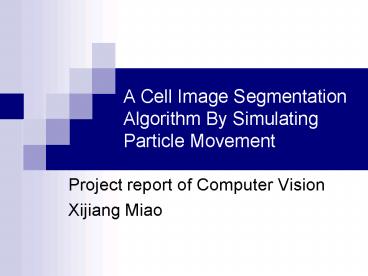A Cell Image Segmentation Algorithm By Simulating Particle Movement
1 / 20
Title:
A Cell Image Segmentation Algorithm By Simulating Particle Movement
Description:
Check the effect a treatment. Integrate into cell sorting machine. 5. Revisit the image ... Adjust the speed and mass according to its neighbors. Record their paths ... –
Number of Views:87
Avg rating:3.0/5.0
Title: A Cell Image Segmentation Algorithm By Simulating Particle Movement
1
A Cell Image Segmentation Algorithm By Simulating
Particle Movement
- Project report of Computer Vision
- Xijiang Miao
2
Outline
- Introduction
- Related works
- The algorithm
- Potential problems
3
Cells under microscope
mitosis
Gap
synthesis
apoptosis
4
Mission Tell apart each cells
- Knowing the number of cell is helpful
- Extract RNA,
- Currently, the number of cells is manually
counted. - Classifying cells in different phase is valuable.
- Check the effect a treatment.
- Integrate into cell sorting machine.
5
Revisit the image
6
Voting Based Algorithm
7
Experimental Result of Simple Voting
8
A recent published vote based algorithm
Yang, Q. et al, Perceptual Organization of Radial
Symmetries, Proceedings of (CVPR04)
9
Watershed algorithm
Fig. 2. Building dams at the places where the
water coming from two different minima would
merge.
Vincent, L. and Soille, P. Watersheds in Digital
Spaces An Efficient Algorithm Based on Immersion
Simulations. IEEE TRANSACTIONS ON PATTERN
ANALYSIS AND MACHINE INTELLIGENCE, VOL. 13, NO.
6, JUNE 1991
10
Watershed
11
Watershed in ImageJ
ImageJ http//rsb.info.nih.gov/ij/ Watershed
plugin Biomedical Imaging Group http//bigwww.epf
l.ch/sage/soft/watershed/
12
Think the pixels as particles
- Think each pixel is a particle with its mass and
velocity. - mAB mA mB
- conservation of momentum
- ? mAvA mBvB (mAmB)vAB
- ? vAB (mAvA mBvB)/(mAmB)
- Interpretation of mass and velocity
13
Think the pixels as particles (2)
- Average Mass and momentum
- Weighted by their mass.
- The overall goal is to
- bring down the effect of noise and
- accelerate the process.
14
The algorithm
- Initialize the mass and speed.
- Repeat
- Move particles at their speed and direction
- Once two particles collide together, merge these
two particles and recalculate their speed and
mass. - Adjust the speed and mass according to its
neighbors. - Record their paths
- Until some terminate condition
- Segment the image according to paths
15
Experiment result
16
Parameters and Options
- Initial parameters
- Mass
- Gradient ?
- Speed
- Gradient w/ tangent direction
- Markers
- Terminate condition
- Limited Steps
- Sand-box
- Compete
- sigma
17
Another example shows some problems
18
The result
19
Problems and workaround
- Global color changes
- Normalize the marginal distribution.
- Big blank area
- Use different initial mass value
20
Question/ Suggestion































